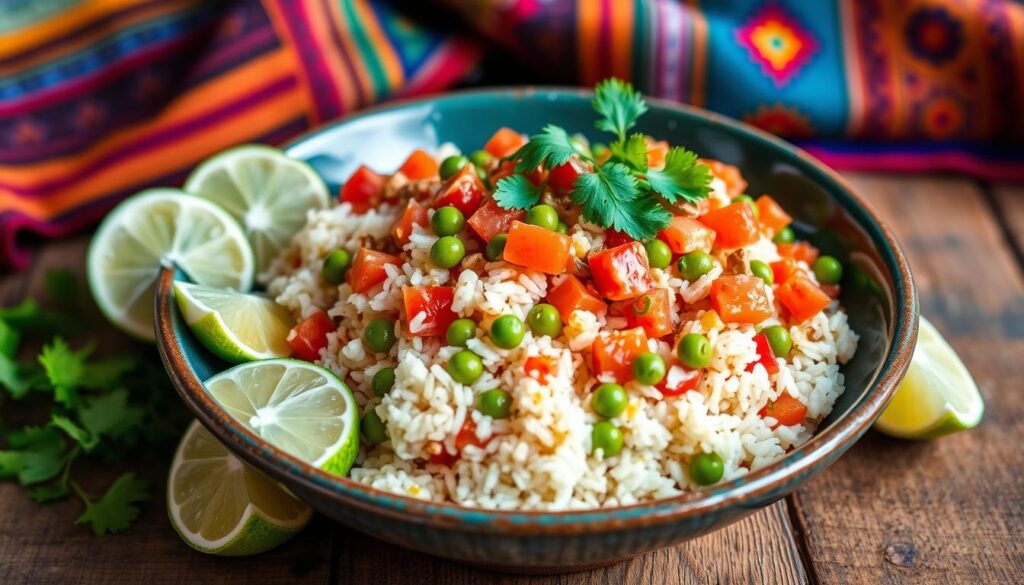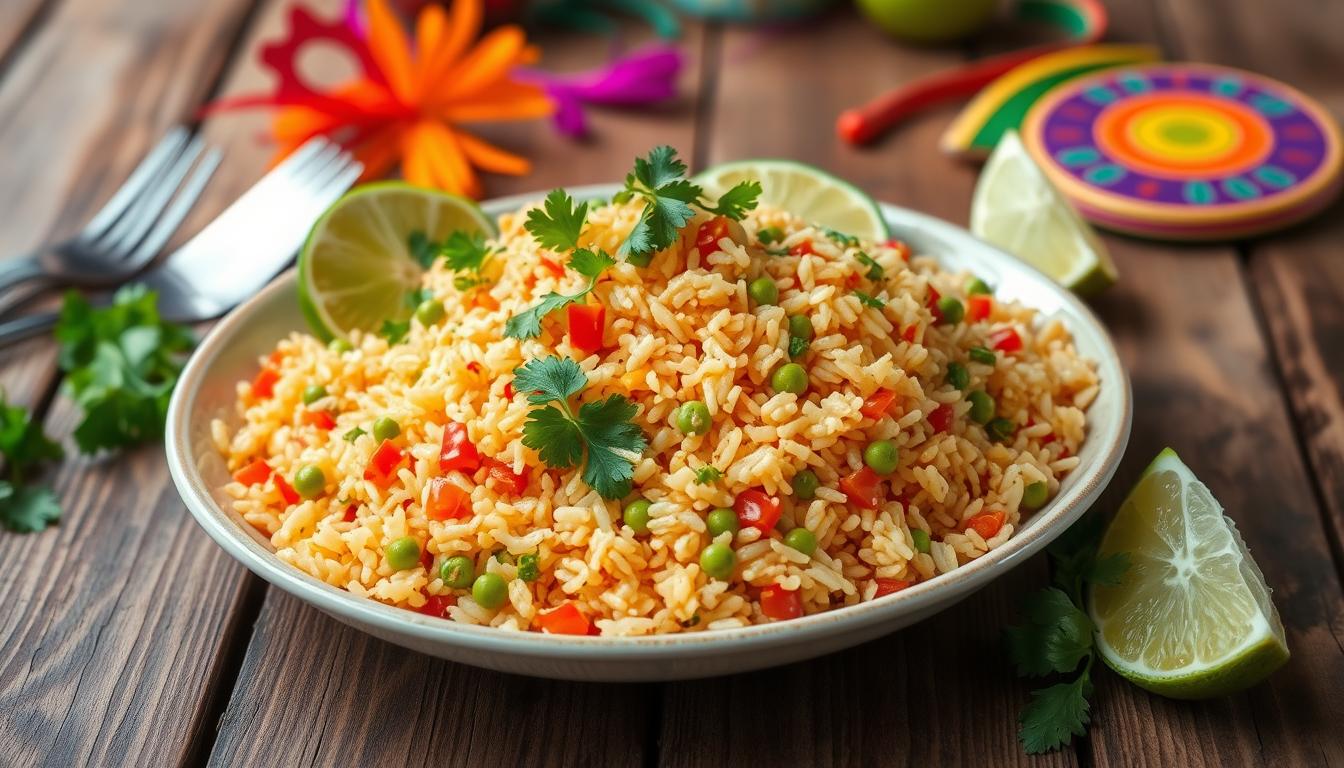Mexican rice, also known as “arroz” in Spanish, is a beloved staple in Mexican cuisine. It has become a symbol of the country’s rich culinary heritage. This dish offers a wide range of flavors and preparations.
From vibrant red rice to fragrant green varieties, Mexican rice showcases the diversity and creativity of Mexican cooking. This article will explore the authentic names, ingredients, and preparation techniques that define this iconic Mexican dish.
Key Takeaways
- Mexican rice, is a staple in Mexican cuisine.
- It comes in a variety of colors and flavors, including red, green, and white rice.
- Mexican rice is a symbol of the country’s rich culinary heritage.
- This versatile dish can be prepared in many different ways.
- Exploring the authentic names, ingredients, and techniques of Mexican rice is the focus of this article.
Unveiling the Flavorful World of Arroz
Mexican rice is a key part of the country’s food culture. It’s loved in homes and restaurants everywhere. Each region has its own twist, showing off Mexico’s varied tastes and cooking ways.
The Beloved Staple of Mexican Cuisine
In central Mexico, you’ll encounter red rice, a dish that fills the air with its inviting aroma. The Yucatan’s green rice bursts with life and color. Every variation of Mexican rice showcases the country’s rich history and culinary creativity.
Regional Variations and Cultural Significance
White rice is a common side dish in Mexico, pairing well with many classic dishes. Rice pudding, known as ‘arroz con leche,’ is a sweet treat enjoyed by many.
In Oaxaca, you can try fried rice, while Veracruz is famous for Cuban-style rice. Each dish tells a story of Mexico’s rich culinary heritage.

“Arroz is not just a side dish in Mexico – it’s a culinary art form that reflects the country’s rich history and cultural identity.”
Arroz Rojo: The Quintessential Mexican Red Rice
Arroz rojo, or Mexican red rice, is a favorite in traditional Mexican cooking. It’s known for its bold flavors and bright red color. It’s often served with tacos, enchiladas, grilled meats, and seafood.
The sauce in arroz rojo is what makes it stand out. It’s made with tomatoes and gives the rice its vibrant color and taste. This shows the depth and complexity of Mexican cooking.
Making perfect arroz rojo starts with choosing the right ingredients. Onions, garlic, and tomatoes create the base. Annatto seeds or tomato sauce add the red color and flavor. The rice cooks in this mix, becoming a vibrant dish that complements Mexican flavors well.
The art and science of making good may seem unrelated, but both require a keen understanding of temperature control, stirring techniques, and ingredient balance to achieve the desired texture and flavor. Just as with fudge, the attention to detail in preparing arroz rojo is what sets it apart as a true culinary masterpiece.

Arroz rojo is a side dish or the star of a Mexican feast. It shows Mexico’s rich cultural heritage and culinary skill. Its versatility makes it a key part of Mexican cuisine.
Ingredients and Preparation Techniques
Mexican rice, or arroz, is made with special ingredients. It starts with onions, garlic, and tomatoes. These mix together to make a base that’s full of flavor.
The Aromatic Base: Onions, Garlic, and Tomatoes
Diced onions, garlic, and tomatoes are key in Mexican rice. They’re cooked until they’re perfect. This makes the rice taste amazing.
The Colorful Addition: Annatto Seeds or Tomato Sauce
To make arroz rojo red, cooks use annatto seeds or tomato sauce. These add color and flavor. Some recipes use tomato sauce for a milder taste.
| Ingredient | Purpose |
|---|---|
| Onions | Provide a savory, aromatic base |
| Garlic | Impart a depth of flavor and pungency |
| Tomatoes | Add a touch of acidity and natural sweetness |
| Annatto seeds or tomato sauce | Lend the distinctive red color to arroz rojo |
“The foundation of authentic Mexican rice lies in the careful selection and combination of key ingredients.”
Arroz Verde: The Vibrant Green Rice Variety
In the rich world of Mexican food, arroz verde, or green rice, is a standout. It gets its bright green color from tomatillos, which add a tangy sweetness. This makes the dish both vibrant and delicious.
The Secret Ingredient: Vibrant Green Tomatillos
Tomatillos are key in making arroz verde. They give the rice a unique flavor and color. Along with onions, garlic, and cilantro, they create a dish that’s both tangy and aromatic.
Arroz verde is great with grilled meats or seafood. Its bright color and bold taste make any meal more elegant. This dish shows off the variety and richness of Mexican cooking.
“The tomatillo’s tart and slightly sweet notes perfectly complement the aromatic base of onions, garlic, and cilantro in arroz verde.”
Arroz verde is a flavorful highlight in Mexican cuisine. It’s perfect as a side or part of a bigger meal. It’s a vibrant and tasty part of Mexico’s culinary world.
Arroz Blanco: The Simple Yet Satisfying White Rice
Mexican cuisine is famous for its colorful and tasty rice dishes. The arroz rojo (red rice) and arroz verde (green rice) are well-known. But, arroz blanco, or white rice, has its own charm and versatility.
Arroz blanco is like a blank canvas. It lets other parts of a meal shine. Its mild taste and fluffy texture pair well with many Mexican dishes. This includes arroz con pollo (chicken and rice) and hearty stews and sauces.
Making arroz blanco is easy. You need long-grain rice, water or broth, and a bit of oil or butter. The secret is in how you cook it. You want each grain to be separate and fluffy, not sticky or clumped.
| Ingredient | Quantity |
|---|---|
| Long-grain rice | 1 cup |
| Water or broth | 2 cups |
| Olive oil or butter | 1 tablespoon |
| Salt | 1/2 teaspoon |
Even though white rice doesn’t have the bright colors or strong tastes of other rice dishes, it’s still a favorite in Mexican cuisine. It provides a simple yet satisfying base for many dishes.
“Arroz blanco is the unsung hero of Mexican rice. It may not steal the spotlight, but it’s the reliable base that allows the other flavors to truly shine.”
arroz
In Spanish, ‘arroz’ refers to various types of Mexican rice dishes, each with its own distinct taste and purpose in cooking. Examples include sweet rice pudding, known as ‘arroz con leche,’ fried rice, and Cuban-style rice served with fried eggs, plantains, and ground beef.
Arroz is great in many Mexican dishes. It can be a sweet arroz con leche dessert or a tasty arroz frito side dish. It shows how creative Mexican cooking can be.
Embracing the Diversity of Arroz
There’s red arroz with tomatoes and spices, green arroz with tomatillos, and simple white arroz. This ingredient lets Mexican chefs show off their skills.
- Arroz con leche: A sweet and comforting rice pudding, often flavored with cinnamon and vanilla.
- Arroz frito: Fried rice, typically made with leftover arroz, vegetables, and proteins.
- Arroz a la cubana: A dish featuring arroz, fried eggs, plantains, and ground beef, showcasing the diverse influences in Mexican cuisine.
Arroz is loved from breakfast to dinner in Mexican cooking. It’s a key part of the country’s culinary traditions, showing the creativity and variety of this simple grain.
Pairing Mexican Rice with Other Dishes
Mexican rice is a fantastic side dish for many traditional meals. It complements dishes like chicken and rice, stews, and fajitas perfectly. Its unique taste and soft texture enhance every meal.
This versatile rice pairs well with grilled meats, seafood, and vegetables. Its mild yet flavorful taste and fluffy texture provide the perfect balance to the bold flavors of the main dishes, creating harmony on your plate.
Complementing Flavors and Textures
Mexican rice is versatile, working well as a simple side or in more complex dishes like paella or risotto. It absorbs the flavors of other ingredients, such as the smoky taste of chicken and rice, making it an essential element in Mexican cooking.
“Mexican rice is the perfect canvas for showcasing the bold flavors and varied textures of authentic Mexican cuisine.”
From light white rice to hearty red rice, this staple complements many dishes, enhancing meals and highlighting the rich diversity of Mexican food.
Nutritional Benefits of Mexican Rice
Mexican rice is not just tasty; it’s also packed with nutrients. It’s a good source of complex carbs, fiber, and vitamins and minerals. Choosing whole grain rice, or arroz integral, makes it even healthier without losing flavor.
One big plus of Mexican rice is its complex carbs. These carbs give you energy slowly and help keep your blood sugar stable. This makes arroz a great choice for a filling meal.
Mexican rice is also rich in dietary fiber. Fiber is good for your digestion and can help you feel full longer. Adding rice integral increases the fiber, making it even better for you.
| Nutrient | Arroz | Arroz Integral |
|---|---|---|
| Carbohydrates | 45g | 50g |
| Fiber | 2g | 4g |
| Protein | 4g | 5g |
| Iron | 2mg | 3mg |
Arroz is also a good source of vitamins and minerals. It can have vitamins A, C, and B-complex, and minerals like iron and magnesium. These nutrients are important for your health and help your body work right.
Whether you choose arroz rojo, arroz verde, or arroz blanco, Mexican rice is a tasty and healthy choice. It lets you enjoy Mexican flavors while also taking care of your body.
Conclusion
The world of Mexican rice is full of life and flavor, showcasing the rich culinary traditions of Mexico. From the bold red rice to the delicate green variety, each type is unique and cherished.
Mexican rice can be enjoyed on its own or as a side with other dishes, making it a favorite among food lovers everywhere. Its simplicity and depth of flavor make it a standout in Mexican cuisine.
As we say goodbye to Mexican rice, its importance is clear. It’s a beloved dish in many kitchens. Whether you’re new to Mexican cooking or a seasoned fan, arroz’s charm will keep you coming back for more.
